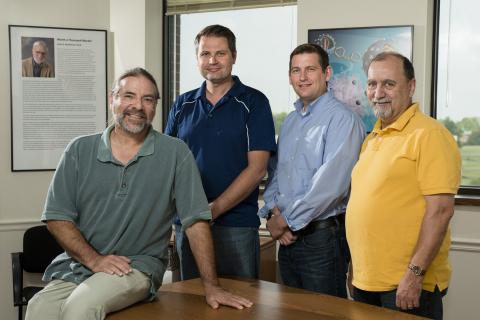
From left: Jeff Lifson, M.D., director of the AIDS and Cancer Virus Program; Brandon Keele, Ph.D., head, Viral Evolution Core; Jacob Estes, Ph.D., head, Tissue Analysis Core; and Michael Piatak, Jr., Ph.D., head, Quantitative Molecular Diagnostics Core. This group collaborated with scientists at the Oregon Health & Science University to advance the line of research culminating in the Nature publication describing a novel vaccine approach that achieved a function cure of the AIDS virus in monkeys
By Frank Blanchard, Staff Writer, and Jeff Lifson, Guest Writer
Scientists at the Oregon Health & Science University and the AIDS and Cancer Virus Program of the Frederick National Laboratory for Cancer Research have used a novel vaccine approach to achieve a “functional cure” and apparent eradication of infection with a monkey version of the AIDS virus.
In a paper published online in Nature, the group reported success with an experimental vaccine for simian immunodeficiency virus (SIV), an AIDS-inducing virus that infects rhesus macaques and is so similar to HIV that it is a widely used model for AIDS studies in monkeys.
Vaccinated animals that were experimentally infected via rectal, vaginal, and intravenous routes—the principal routes of HIV transmission—were able to control the infection with a highly pathogenic strain of SIV, reducing the amount of virus in the blood to below detectable levels. After up to three years of follow-up, the investigators were unable to demonstrate the presence of SIV, despite extensive analysis of many necropsy tissues, using ultra-sensitive, state-of-the-art assays.
To further investigate the apparent clearance of infection, the investigators studied several animals in detail, taking repeated tissue samples from the animals, starting as soon as they first showed evidence of controlling the virus. Results showed they were definitely infected, with clear initial evidence of virus in the sampled tissues. The animals also developed new immune responses against parts of SIV that were not included in the vaccine. Over time, however, the scientists could no longer detect evidence of the virus or culture it, or measure the new infection-dependent immune responses. In contrast, immune responses induced by the vaccine remained robust and stable.
Perhaps most dramatically, when investigators transferred large numbers of cells to new uninfected animals, using cells from infected donors that were either rare animals that showed spontaneous control of SIV infection, or animals receiving suppressive antiretroviral drug treatment, the recipients rapidly showed evidence of high levels of infection. In striking contrast, using the same cell transfer procedure from vaccinated animals that appeared to have cleared their infections, there was no evidence of infection in the recipients over extended follow-up.
The research team stopped short of saying that the virus was completely gone, but they wrote, “these data strongly support progressive immune-mediated clearance of an established lentivirus infection, leading to a situation meeting criteria for a functional cure and consistent with possible viral eradication.”
The milestone, published in Nature the week of September 11, is the latest step in an ongoing line of collaborative research in which the investigators have been testing a new approach for developing an AIDS vaccine.
To read the whole paper, go to http://www.nature.com/nature/journal/vaop/ncurrent/full/nature12519.html.
Jeff Lifson, M.D., is the director of the AIDS and Cancer Virus Program.

